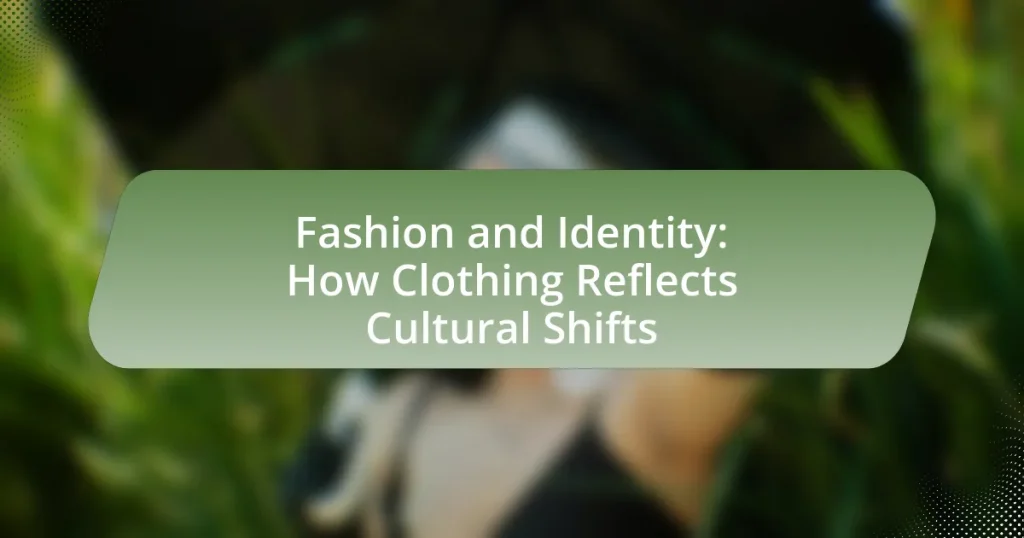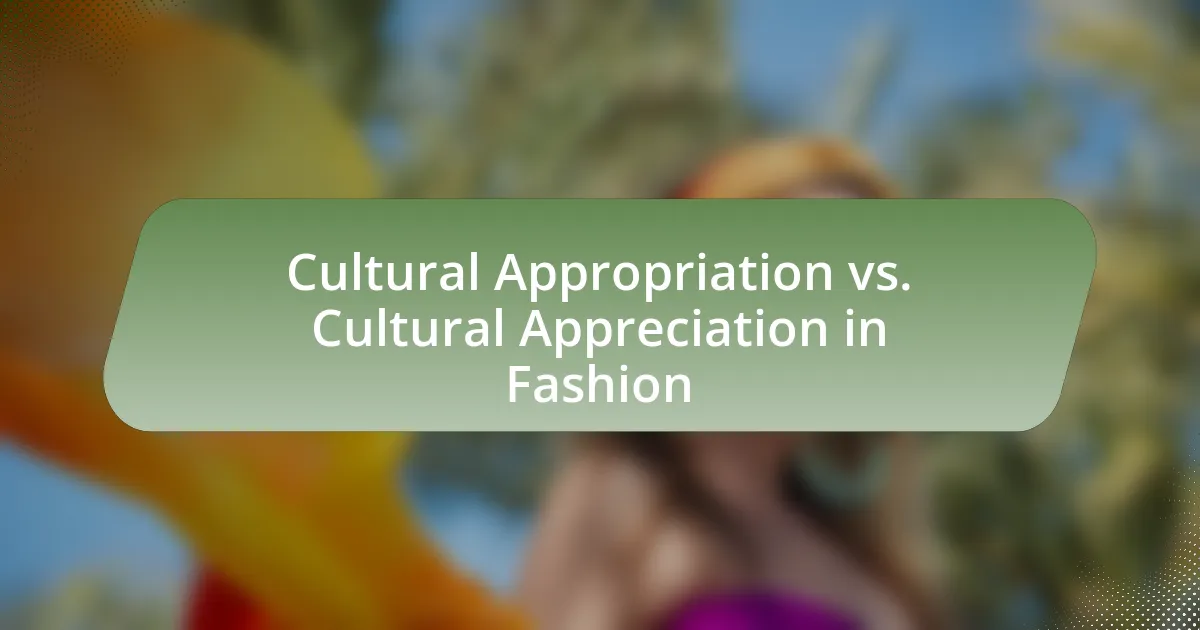The article examines the intricate relationship between fashion and identity, highlighting how clothing choices serve as a form of self-expression and social signaling. It explores the cultural factors that influence personal style, the impact of societal norms on fashion perceptions, and the role of historical events and social movements in shaping trends. Additionally, the article discusses how globalization, technology, and social media have transformed consumer behavior and fashion identity, while addressing ethical considerations surrounding cultural appropriation. Ultimately, it emphasizes the significance of fashion as a reflection of cultural shifts and individual identity.
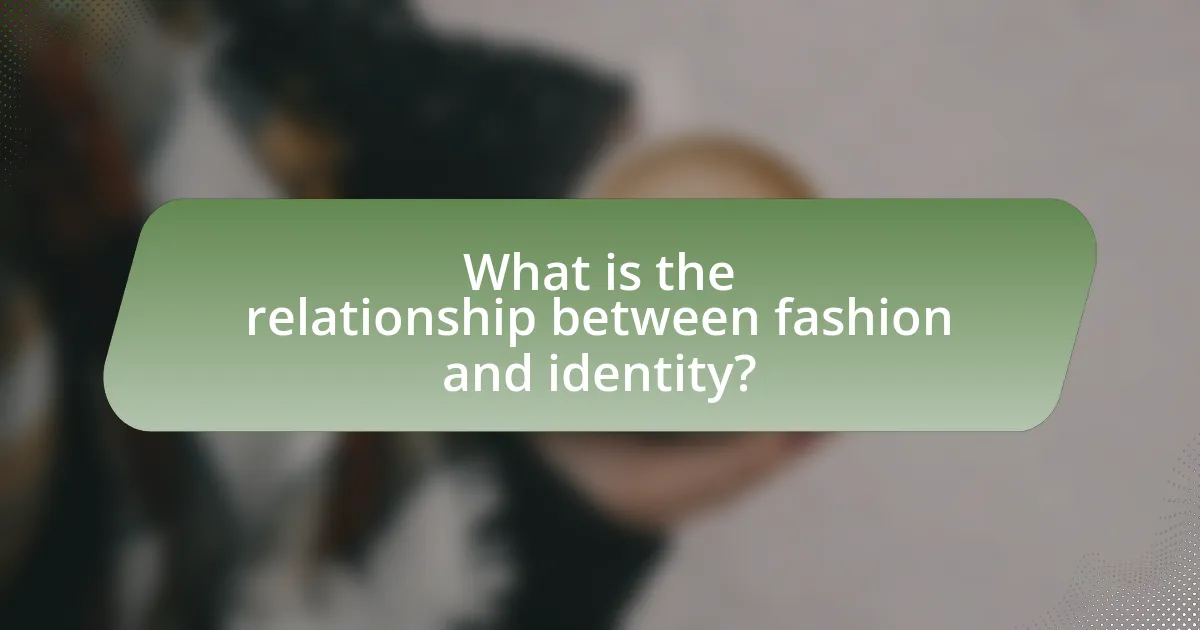
What is the relationship between fashion and identity?
Fashion and identity are intrinsically linked, as clothing choices serve as a means of self-expression and social signaling. Individuals often use fashion to communicate their personal beliefs, cultural backgrounds, and social affiliations. For instance, studies have shown that clothing can influence perceptions of personality traits, with specific styles associated with particular identities, such as punk fashion reflecting rebellion or business attire signaling professionalism. This relationship is further evidenced by the role of fashion in social movements, where clothing becomes a symbol of collective identity, such as the use of black clothing in the Black Lives Matter movement to signify solidarity.
How does clothing serve as a form of self-expression?
Clothing serves as a form of self-expression by allowing individuals to communicate their identity, beliefs, and emotions through their style choices. This is evident in how fashion trends often reflect cultural movements, such as the punk movement of the 1970s, where clothing became a symbol of rebellion and individuality. Studies show that people use clothing to convey messages about their social status, group affiliation, and personal values, with specific garments often associated with particular subcultures or ideologies. For instance, the adoption of sustainable fashion reflects a growing awareness of environmental issues, showcasing how clothing choices can align with personal and societal values.
What cultural factors influence personal style choices?
Cultural factors that influence personal style choices include traditions, social norms, and historical context. These elements shape individuals’ perceptions of fashion and dictate what is considered acceptable or desirable within a specific culture. For instance, in many Eastern cultures, modesty is a significant factor, leading to styles that prioritize coverage and subtlety, while Western cultures may emphasize individual expression and trendiness. Additionally, cultural events, such as festivals or ceremonies, often dictate specific attire, reinforcing communal identity and values. Historical events, such as the civil rights movement, have also influenced fashion, as seen in the adoption of styles that symbolize resistance and empowerment.
How do societal norms shape our understanding of fashion?
Societal norms significantly shape our understanding of fashion by establishing the standards and expectations regarding acceptable attire within a culture. These norms dictate what is considered fashionable or unfashionable, influencing individual choices and collective trends. For instance, in many Western societies, norms around professionalism have led to the prevalence of business attire such as suits in corporate environments, while casual wear is often accepted in more relaxed settings. Historical shifts, such as the women’s liberation movement in the 1960s, challenged traditional gender norms and expanded the definition of acceptable women’s fashion, leading to the adoption of more diverse styles. This interplay between societal expectations and fashion choices illustrates how cultural values and beliefs directly impact our perceptions and expressions of identity through clothing.
Why is fashion considered a reflection of cultural shifts?
Fashion is considered a reflection of cultural shifts because it embodies the values, beliefs, and social dynamics of a particular time and place. For instance, the rise of casual wear in the late 20th century mirrored the increasing emphasis on individualism and comfort in society, as seen in the popularity of brands like Levi’s and Nike. Additionally, movements such as feminism and civil rights have influenced fashion trends, with the adoption of styles like the power suit in the 1980s symbolizing women’s empowerment in the workplace. These examples illustrate how fashion not only responds to but also actively shapes cultural narratives, making it a significant indicator of societal change.
What historical events have influenced fashion trends?
Historical events such as the Industrial Revolution, World War I, and the women’s suffrage movement have significantly influenced fashion trends. The Industrial Revolution, which began in the late 18th century, introduced mass production techniques that made clothing more accessible and affordable, leading to the rise of ready-to-wear fashion. World War I, occurring from 1914 to 1918, prompted women to adopt more practical clothing styles as they entered the workforce, resulting in the popularity of tailored suits and shorter hemlines. Additionally, the women’s suffrage movement in the early 20th century challenged traditional gender roles, leading to the adoption of more liberated and functional clothing, such as the flapper dress in the 1920s. These events collectively shaped societal attitudes towards fashion, reflecting broader cultural shifts and changes in identity.
How do movements in art and music impact clothing styles?
Movements in art and music significantly influence clothing styles by reflecting the cultural and aesthetic values of their time. For instance, the emergence of the Impressionist movement in the late 19th century inspired softer, more fluid clothing designs that mirrored the movement’s emphasis on light and color. Similarly, the punk rock movement of the 1970s introduced bold, rebellious fashion choices characterized by leather jackets, ripped jeans, and DIY aesthetics, which were a direct response to the socio-political climate of that era. These examples illustrate how artistic and musical expressions shape fashion trends, creating a dialogue between cultural movements and clothing styles that resonates with societal changes.
In what ways does fashion communicate identity?
Fashion communicates identity through the expression of personal style, cultural affiliation, and social status. Individuals use clothing choices to convey their beliefs, values, and group memberships, which can be observed in various cultural and subcultural contexts. For example, the punk movement in the 1970s utilized distinctive fashion elements like leather jackets and ripped jeans to signify rebellion against mainstream norms. Additionally, fashion can reflect socioeconomic status, as luxury brands often symbolize wealth and exclusivity. Studies show that clothing can influence perceptions of professionalism and competence, further illustrating how fashion serves as a non-verbal communication tool that shapes identity in social interactions.
How do different demographics express their identities through clothing?
Different demographics express their identities through clothing by utilizing styles, colors, and patterns that reflect their cultural backgrounds, social status, and personal beliefs. For instance, individuals from urban environments often adopt streetwear, which signifies a connection to contemporary youth culture and social movements, while traditional attire may be worn by those from rural or indigenous backgrounds to honor heritage and community values. Research indicates that clothing choices can serve as a form of non-verbal communication, allowing individuals to signal group membership and personal identity. A study published in the Journal of Consumer Research by authors such as K. M. K. K. and J. M. S. highlights that clothing can influence perceptions of social identity, demonstrating how fashion choices are intertwined with demographic factors like ethnicity, age, and socioeconomic status.
What role does fashion play in group identity and belonging?
Fashion serves as a crucial medium for expressing group identity and fostering a sense of belonging among individuals. By adopting specific styles, colors, and symbols, members of a group can visually communicate their affiliation and shared values, which reinforces social bonds. For instance, subcultures such as punk or goth utilize distinct fashion elements to signify their identity and differentiate themselves from mainstream society. Research by sociologist Thorstein Veblen highlights that clothing choices often reflect social status and group membership, further validating the role of fashion in establishing collective identity.
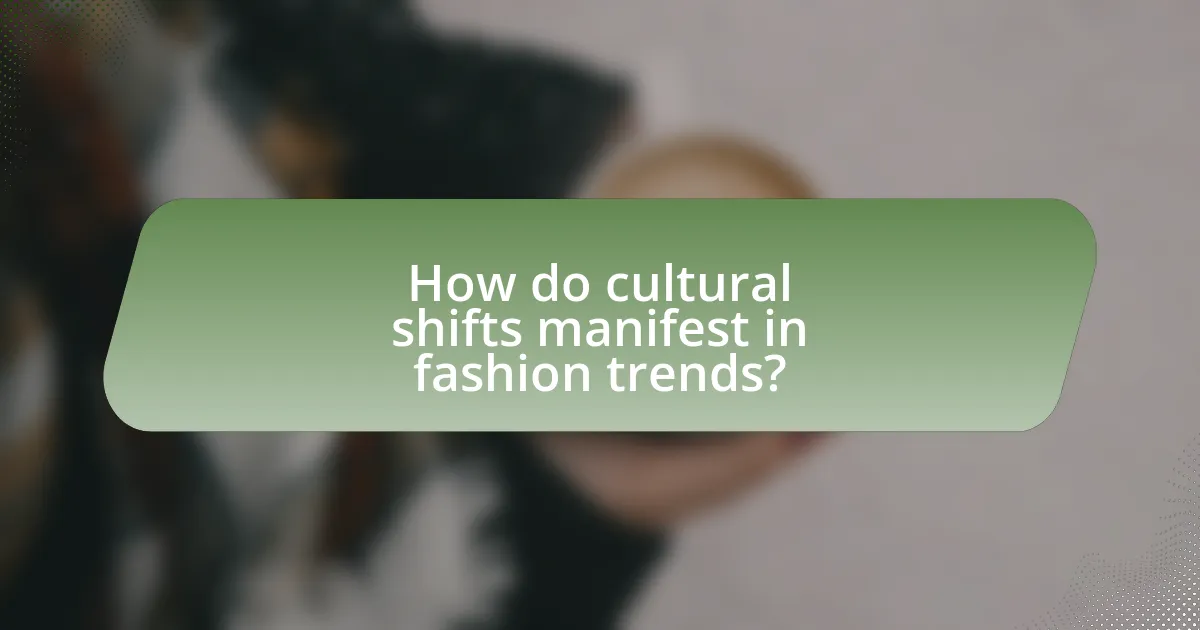
How do cultural shifts manifest in fashion trends?
Cultural shifts manifest in fashion trends through the adoption of styles that reflect societal values, beliefs, and changes in demographics. For instance, the rise of feminism in the 1960s led to the popularity of more practical and less restrictive clothing, such as pants for women, symbolizing a move towards gender equality. Additionally, the influence of social movements, such as the LGBTQ+ rights movement, has resulted in vibrant, expressive fashion choices that challenge traditional norms. Historical events, like the civil rights movement, have also prompted fashion statements that signify resistance and identity, such as the use of African prints and styles in the 1970s. These examples illustrate how fashion serves as a visual representation of cultural evolution and collective identity.
What are some examples of fashion trends that reflect cultural changes?
Fashion trends that reflect cultural changes include the rise of athleisure, which signifies a shift towards health and wellness, and the popularity of sustainable fashion, reflecting growing environmental awareness. Athleisure emerged in the 2010s as activewear became acceptable in everyday settings, driven by a cultural emphasis on fitness and casual lifestyles. Sustainable fashion gained traction in response to increasing concerns about climate change and ethical production practices, with brands like Stella McCartney leading the way in eco-friendly designs. These trends illustrate how societal values and priorities shape clothing choices, demonstrating a direct link between fashion and cultural evolution.
How did the feminist movement influence women’s fashion?
The feminist movement significantly influenced women’s fashion by promoting clothing that emphasized comfort, practicality, and self-expression over traditional femininity. In the 1960s and 1970s, the movement encouraged women to reject restrictive garments like corsets and high heels, leading to the popularization of more functional attire such as pants, overalls, and casual wear. This shift was exemplified by the adoption of styles like the miniskirt and the pantsuit, which symbolized women’s liberation and equality in the workplace. The feminist movement also fostered a culture of body positivity and diversity, challenging conventional beauty standards and encouraging women to dress in ways that reflected their individuality rather than societal expectations.
What impact has globalization had on local fashion industries?
Globalization has significantly transformed local fashion industries by increasing competition and facilitating the exchange of cultural influences. This shift has led to the emergence of hybrid styles that blend traditional elements with global trends, allowing local designers to reach broader markets. For instance, the rise of fast fashion brands has pressured local artisans to adapt quickly to changing consumer preferences, often resulting in the loss of traditional craftsmanship. According to a study by the International Journal of Fashion Design, Technology and Education, globalization has also enabled local brands to leverage online platforms, expanding their visibility and sales potential beyond regional boundaries.
How do social media and technology affect fashion trends?
Social media and technology significantly influence fashion trends by enabling rapid dissemination of styles and fostering real-time engagement between brands and consumers. Platforms like Instagram and TikTok allow users to share fashion content instantly, creating viral trends that can emerge overnight. For instance, a study by the Fashion Institute of Technology found that 70% of consumers are influenced by social media when making fashion purchases, highlighting the direct impact of these platforms on consumer behavior. Additionally, technology such as augmented reality (AR) and virtual fitting rooms enhances the shopping experience, allowing consumers to visualize how clothing will look on them before making a purchase, further shaping their fashion choices.
What role do influencers play in shaping contemporary fashion?
Influencers play a crucial role in shaping contemporary fashion by driving trends and consumer behavior through their social media platforms. They curate styles, promote brands, and create aspirational lifestyles that resonate with their followers, leading to significant shifts in fashion preferences. For instance, a study by the Fashion Institute of Technology found that 70% of consumers are influenced by social media when making fashion purchases, highlighting the direct impact influencers have on buying decisions. Additionally, influencers often collaborate with brands to launch exclusive collections, further solidifying their influence in the fashion industry.
How has online shopping transformed consumer behavior in fashion?
Online shopping has significantly transformed consumer behavior in fashion by increasing accessibility and convenience, leading to a shift in purchasing patterns. Consumers now prefer the ability to browse and purchase clothing from anywhere at any time, which has resulted in a decline in traditional brick-and-mortar shopping. According to a report by Statista, global online fashion sales reached approximately $600 billion in 2021, highlighting the growing trend of online purchases over in-store shopping. This shift has also encouraged consumers to engage in comparison shopping, utilizing online reviews and social media to inform their decisions, thereby altering the way fashion brands market their products.
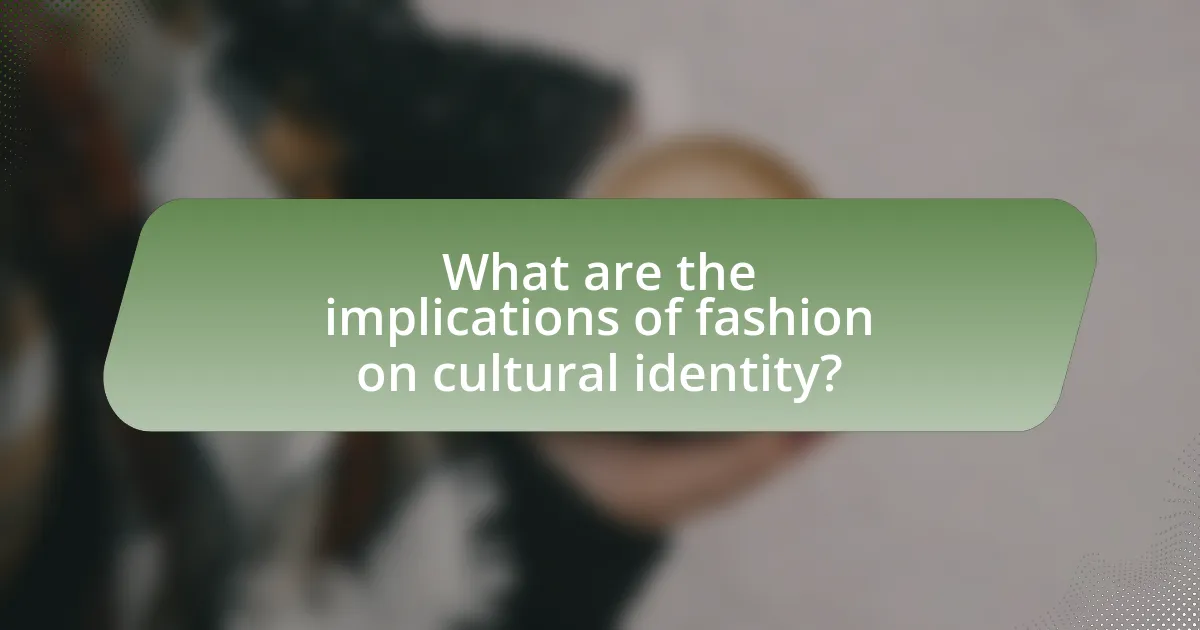
What are the implications of fashion on cultural identity?
Fashion significantly influences cultural identity by serving as a medium through which individuals express their heritage, beliefs, and social affiliations. Clothing choices often reflect cultural narratives, allowing people to communicate their identity and values visually. For instance, traditional garments like the kimono in Japan or the sari in India are not only fashion statements but also embody historical and cultural significance, reinforcing a sense of belonging and continuity within those cultures. Furthermore, fashion can act as a catalyst for cultural exchange, as seen in the global popularity of streetwear, which merges diverse cultural elements and fosters a shared identity among youth across different backgrounds. This interplay between fashion and cultural identity highlights how clothing can both preserve and transform cultural expressions in response to societal changes.
How does fashion contribute to cultural appropriation debates?
Fashion contributes to cultural appropriation debates by often borrowing elements from marginalized cultures without proper acknowledgment or respect. This appropriation can lead to the commodification of cultural symbols, stripping them of their original significance and context. For instance, the use of Native American headdresses in fashion shows has sparked controversy, as these items hold deep spiritual meaning and are traditionally worn by specific individuals in those cultures. The debate intensifies when fashion brands profit from these appropriated elements while the original cultures face ongoing discrimination and economic disadvantage. Thus, fashion serves as a focal point for discussions about power dynamics, representation, and the ethical responsibilities of designers and consumers in a globalized world.
What are the ethical considerations in borrowing styles from other cultures?
Borrowing styles from other cultures raises ethical considerations such as cultural appropriation, respect for cultural significance, and the impact on marginalized communities. Cultural appropriation occurs when elements of a culture are used without permission or understanding, often leading to the commodification of sacred symbols or traditional attire. For instance, the use of Native American headdresses in fashion shows has sparked controversy, as these items hold deep spiritual significance and are not merely aesthetic choices. Additionally, the lack of representation and profit-sharing with the original culture can perpetuate inequalities, as seen in the fashion industry where designers profit from cultural elements without acknowledging their origins. Ethical borrowing requires sensitivity, acknowledgment, and collaboration with the cultures being represented to ensure respect and fairness.
How can fashion promote cultural appreciation versus appropriation?
Fashion can promote cultural appreciation by emphasizing authentic representation and collaboration with cultural communities, while avoiding appropriation through respectful engagement and understanding. When designers incorporate elements from diverse cultures, they should seek input and partnership from those communities, ensuring that the cultural significance is honored. For instance, the use of traditional textiles or motifs can be celebrated through collaborations with artisans from those cultures, as seen in brands like Stella McCartney, which has worked with Indigenous communities to create sustainable fashion that respects their heritage. This approach fosters mutual respect and understanding, contrasting with appropriation, where cultural elements are used without acknowledgment or respect for their origins.
What future trends might emerge from current cultural shifts?
Future trends that might emerge from current cultural shifts include increased emphasis on sustainability in fashion, as consumers become more environmentally conscious. This shift is evidenced by the rise of brands prioritizing eco-friendly materials and ethical production practices, reflecting a broader societal demand for responsible consumption. Additionally, the blending of gender norms in clothing is likely to continue, as seen in the growing popularity of gender-neutral fashion lines, which cater to a diverse range of identities and expressions. This trend is supported by data indicating that younger generations increasingly reject traditional gender binaries, seeking clothing that aligns with their personal identities rather than societal expectations.
How can sustainability influence future fashion choices?
Sustainability can significantly influence future fashion choices by driving consumer demand for eco-friendly materials and ethical production practices. As awareness of environmental issues grows, consumers increasingly prefer brands that prioritize sustainability, leading to a shift in market dynamics. For instance, a 2021 survey by McKinsey & Company found that 67% of consumers consider the use of sustainable materials important when making fashion purchases. This trend encourages brands to innovate in sustainable practices, such as using recycled fabrics and reducing waste, ultimately reshaping the fashion industry towards more responsible consumption.
What role will technology play in the evolution of fashion identity?
Technology will significantly shape the evolution of fashion identity by enabling personalized experiences and fostering new forms of expression. Innovations such as artificial intelligence and augmented reality allow consumers to customize clothing and visualize outfits in real-time, enhancing individual identity through tailored fashion choices. For instance, platforms like Stitch Fix utilize algorithms to curate personalized clothing selections based on user preferences, demonstrating how technology can directly influence personal style. Additionally, social media platforms amplify diverse fashion identities by providing a space for individuals to showcase their unique styles, thus reflecting broader cultural shifts. The integration of technology in fashion not only transforms how individuals express themselves but also redefines collective fashion narratives in contemporary society.
What practical steps can individuals take to express their identity through fashion?
Individuals can express their identity through fashion by selecting clothing that reflects their personal values, cultural background, and individual style. This can be achieved by curating a wardrobe that includes items representing their heritage, such as traditional garments or accessories, which can serve as a conversation starter and a means of cultural expression. Additionally, individuals can choose sustainable and ethical brands that align with their values, showcasing their commitment to social and environmental issues. Engaging in DIY fashion projects allows for customization and personalization, further emphasizing one’s unique identity. Research indicates that clothing choices significantly influence self-perception and social interactions, reinforcing the idea that fashion is a powerful medium for identity expression.
How can one curate a wardrobe that reflects personal values and identity?
To curate a wardrobe that reflects personal values and identity, individuals should first identify their core beliefs and the messages they wish to convey through their clothing choices. This process involves evaluating personal interests, cultural backgrounds, and ethical considerations, such as sustainability and social responsibility. For instance, a study by the Fashion Institute of Technology found that consumers increasingly prefer brands that align with their values, indicating that clothing choices can significantly impact self-expression and identity. By selecting garments that resonate with these identified values, individuals can create a wardrobe that authentically represents who they are.
What resources are available for exploring diverse fashion influences?
Resources for exploring diverse fashion influences include academic journals, fashion history books, online databases, and cultural exhibitions. Academic journals such as “Fashion Theory” and “The Journal of Dress History” provide peer-reviewed articles that analyze the intersection of fashion and culture. Fashion history books, like “The Fashion System” by Roland Barthes, offer insights into how clothing reflects societal changes. Online databases, such as JSTOR and Google Scholar, allow access to a wide range of scholarly articles on fashion influences. Additionally, cultural exhibitions at museums, such as the Costume Institute at the Metropolitan Museum of Art, showcase diverse fashion narratives and their historical contexts. These resources collectively enhance understanding of how fashion serves as a reflection of cultural shifts.
